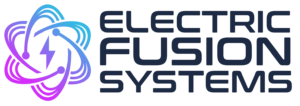A Novel Approach to Fusion
At Electric Fusion Systems, Inc., we are pioneering a groundbreaking and efficient pathway to harnessing fusion energy. Our approach is not only safe but also sustainable, ensuring a greener tomorrow. Our revolutionary technology is versatile, offering limitless possibilities from portable applications like automotive transportation to large-scale industrial and electric utility solutions.
As a team of innovators, we’ve developed a direct-to-electricity technology that seamlessly integrates our patent-pending proton-lithium Quantum Plasma State (QPS) fusion fuel with advanced pulsed electrical stimulation. This synergy ensures fusion power generation is not only more efficient but also vastly affordable, delivering economic benefits that are 10-100 times more favorable than any other energy source.
Key Features of Our Approach:
-
Safety and Sustainability:
- Our fusion technology is designed with safety as a priority, ensuring minimal environmental impact and contributing to a sustainable future.
-
Versatile Applications:
- From automotive transportation to large-scale industrial and utility solutions, our technology offers a wide range of applications, adapting to various energy needs.
-
Direct-to-Electricity Conversion:
- By directly converting fusion energy into electricity, our technology eliminates the inefficiencies associated with traditional thermal conversion methods.
-
Economic Benefits:
- Our fusion technology provides a cost-effective energy solution, with economic advantages significantly surpassing those of current energy sources.
-
Quantum Plasma State (QPS) Fusion Fuel:
- Utilizing advanced Quantum State theory, our QPS fusion fuel maximizes efficiency by enhancing electron interactions and reducing the Coulomb barrier.
-
AI-Driven Modeling and Analysis:
- Leveraging advanced AI, we conduct in-depth modeling and analysis to optimize fusion conditions and ensure the highest possible efficiency and output.
-
Quantum Computing Principles:
- Similar to quantum computing, our approach utilizes the principles of superposition and entanglement to model and predict complex interactions within the fusion process, achieving insights that classical methods cannot.
Join us on our mission to create a sustainable, brighter, and limitless future. Watch our video to learn more about our journey and the transformative potential of our fusion technology.
Efficient, Safe, and Sustainable Power
Synergy in Fusion Initiation
Integrated Approach: The combination of electrical oscillation-induced Coulomb explosions with focused magnetohydrodynamic shockwave’s provides a unique and controlled method for initiating fusion. This integrated approach ensures the HRM plasma reaches the necessary high-density and high-temperature conditions for fusion in a localized and controlled manner.
Reproducibility and Control: The precise control over electrical oscillations and shockwave propagation allows for consistent initiation of fusion reactions, critical for the LEEF reactor’s continuous operation and stable energy production.
Operational Advantages
Efficiency and Safety: This method of initiating fusion maximizes the efficiency of energy conversion from input to plasma conducive to fusion, while maintaining safety through controlled and localized reactions.
Scalability and Application Flexibility: The initiation mechanism’s inherent scalability and adaptability make it suitable for a wide range of reactor sizes and energy applications. Precise control over the fusion initiation process enhances the LEEF technology’s versatility across different operational scenarios.
Incorporating electrical oscillation-induced Coulomb explosions and focused magnetohydrodynamic shockwaves into the fusion initiation process, EFS’s LEEF technology establishes optimal conditions for fusion within HRM fuel. This innovative approach underscores LEEF’s potential to advance fusion energy, offering a path toward efficient, safe, and sustainable power generation.
Our Fusion Fuel is the Key Ingredient
In short, lithium-ammonia has weird properties. Remarkably, in going from a dilute to a concentrated regime, the overall density of the fuel is found to decrease by about 30% by changing its molecular bonding into a tight tetrahedral structure. It also exhibits electron tunneling that lowers the coulomb barrier. Finally, the valence electrons of Li(NH3)4 are in a Rydberg-like state where the odd electron is at a higher quantum number (orbital) whose main density lies quite far outside the hydrogen atoms on ammonia.
A New Direction
Electric Fusion’s technology is a different approach to fusion. Our designs are cyclical, using a conductive metallic dense fuel, external alpha sources to catalyze the fusion process, and finally electric current to push massive amounts of electrons through the fuel to ensure fusion. This is possible because of the conductivity of the fuel-plasma, its Rydberg like atoms and the electron screening that lowers the coulomb barrier to improve fusion probabilities.
In our roller-bag sized electric fusion generator, delivering kilowatts we use the above fuel and process in a sealed cartridge with a specialized switching power supply that controls the rate of fusion reactions and power output level. You might think of it as an electrical transformer, but instead of an iron core it has a fusion driven plasma core electrical transformer.
What’s important to know about Rydberg atoms are their peculiar properties including an exaggerated response to electric and magnetic fields all of which helps our fusion design approach.
